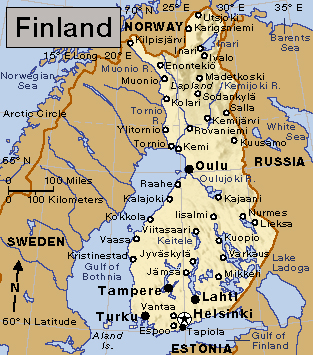Finnish is the language spoken by about 90 percent of the people living in the northern European nation of Finland. Finnish is also an official language in neighboring Sweden, where about five percent of the people speak the unusual tongue. Finnish is spoken in parts of Russia and in far northern Norway, and a few Finnish-speaking communities exist in the United States and Canada. Finnish is one of the 24 official languages of the European Union, but it is one of the least used.
For much of Finland’s history, the country was part of Sweden, and Swedish was the official language. Finland was controlled by Russia from 1809 until 1917, but Finnish gained official status in the region in 1902. Today, Finland has two official languages—Finnish and Swedish. Most of the people speak Finnish, and many speak Swedish. Most of the Swedish-speaking people live on the south and west coasts and on the offshore Aland Islands. Many Finns also speak English.
Finnish and Swedish belong to different language families. Swedish is an Indo-European language, while Finnish is part of the Uralic language family, a small group that includes Estonian and Hungarian (also called Magyar). Languages in this family can be found in northern Europe and northwestern Asia. Finnish has a reputation for being one of the world’s most difficult languages to learn. There are seven main dialects in Finland, each with its own sub-dialects and slang terms. Finnish has fourteen noun cases. There are six verb types, each classed by its stem. The stems alter as the verbs are conjugated. The language modifies and inflects nouns, adjectives, pronouns, numerals, and verbs, depending on their usage in a sentence. The Finnish alphabet has 29 letters, 26 of which are commonly used. Finnish has no gender pronouns.

Unlike other European languages, Finnish has few words that have made their way into the English language. The main exception is sauna, the name for a special kind of steam bath popular for both cleansing and relaxation. The Finnish word for Monday is maanantai <<MAN en ty>>.
During the Middle Ages (A.D. 400's through the 1400's), Finnish was almost exclusively a spoken language. In writing, Finnish speakers used a form of German for business, Swedish for government, and Latin for religious activities. The first known written document in Finnish dates from the early 1200’s. The first comprehensive Finnish writing system was created in the 1500’s. It was based on German, Latin, and Swedish.
The father of the modern Finnish language was Elias Lonnrot, a folklore scholar. In the early 1800’s, Lonnrot made several journeys to eastern Finland, gathering ballads, lyrical songs, and chants that were part of Finnish oral tradition. He compiled this material into the Kalevala, which became the Finnish national epic (long narrative poem). The Kalevala had an enormous impact on the development of modern Finnish.
Untitled Document
Can't view the linked articles? Subscribe to World Book Online

World Book Online delivers a progressive sequence of core databases supported by supplemental
tools, such as language translation, graphic organizers, and unique Webquests. Moving from
Early World of Learning to World Book Advanced, World Book Online aligns end-users with their
appropriate learning levels. Each stand-alone site provides additional features to support the
needs of users’ specific capabilities.
The World Book Difference
World Book combines cutting-edge technology with traditional editorial excellence to produce
authoritative, trustworthy, and unbiased content. The digital content is updated in real time and
carefully curated for each learning level. Accessible 24/7, the content is available on a variety of devices.
World Book Online combines 21st-century instructional techniques with timely information.
By breaking down complex topics and using easily understandable text, World Book Online helps to
build fluency and increase comprehension. Featuring single sign-on capability, these sites are paired
with highly visual content to engage even the most reluctant reader. Our collection of resources kindles
a lifelong learning experience for every user. This adherence to clarity, currency, and accuracy makes
World Book’s digital offerings an information hub for the classroom, library, and beyond.
Image 1: The flag of Finland is white with a large blue cross. The color blue represents Finland’s lakes. White represents the snow that covers Finland during the winter. Credit: © T. Lesia, Shutterstock
Image 2: Finland. Credit: WORLD BOOK map